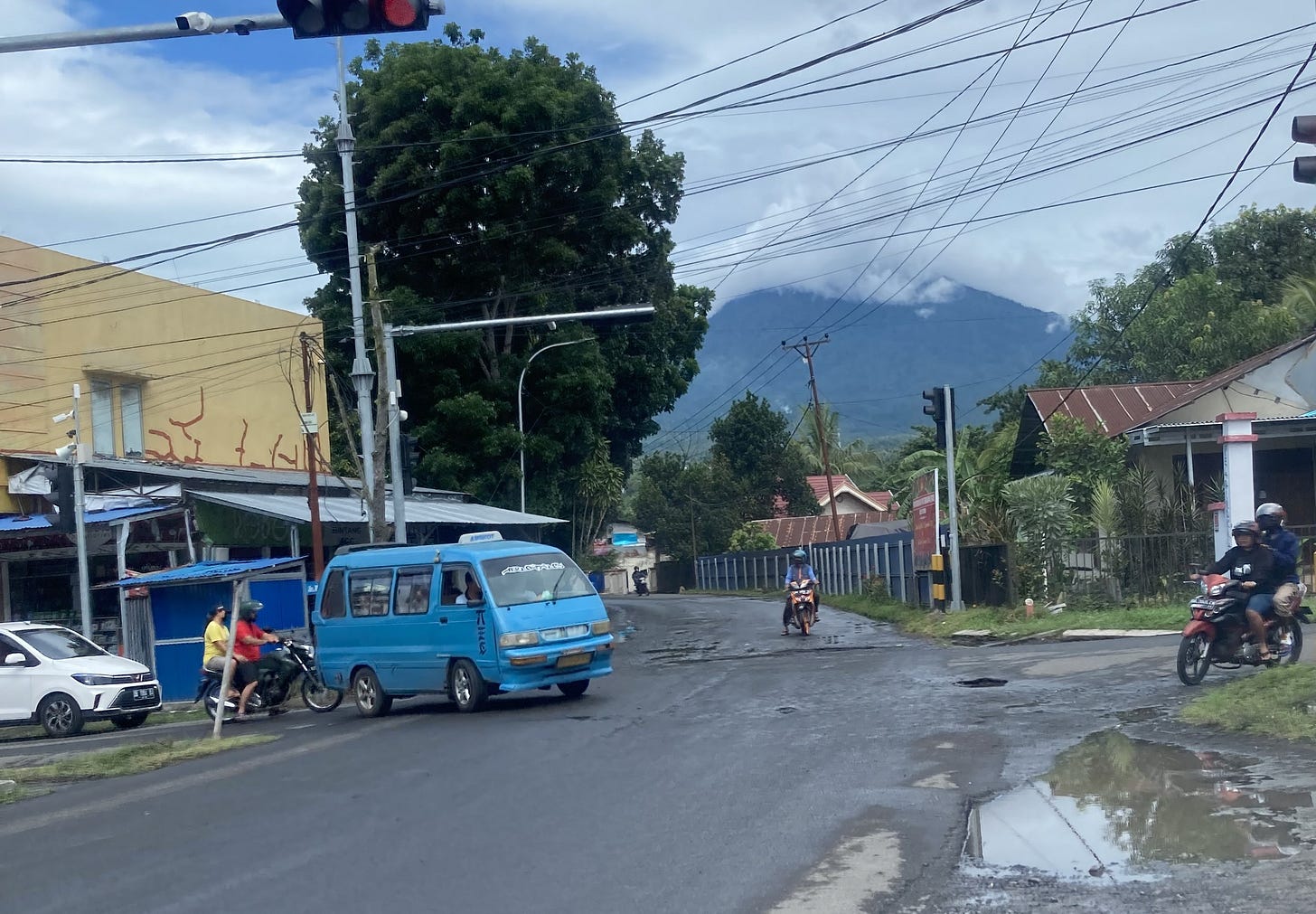
Sitting in the back of the rickety blue minibus, I watch the rugged countryside of Minahasa roll by; undulating hills crowned by trees covered in drooping ferns and shaggy moss; between them a patchwork of scrubby forest and fruit tree gardens- groves of banana, papaya, mango, coconut. In the early morning, over 2000 feet above the sweltering lowlands, the moist air rolling in from the Pacific becomes pleasantly chilled, creating a temperate climate directly on the equator!
In front of me sit two elderly men, with missing teeth and smiling, lined faces, and skin turned earth-brown from years of working in the sun. These two opa-opa (‘grandpas’, a term for older men in Dutch-influenced Manado dialect) are engaged in some sort of lively discussion about family matters. They laugh and gesticulate, apparently uninterested in the foreigner sitting behind them. They wear the provincial uniform of baseball caps, slacks and flip flops. Despite my decent knowledge of Indonesian, I can barely understand a word. That is because they are not speaking Indonesian.
The language these old men speak, one of several unique to North Sulawesi’s Minahasa region, has little resemblance to Indonesian, or for that matter, to any ‘official’ speech of any country. Deep and guttural, yet somehow fluid, the syllables flow off the tongue, propelled by a transformation of ‘b’s and ‘p’s’ into ‘w’s’. The language sounds at home here, it rolls gently like the forested hills, bubbles and hisses like hotsprings, sings sadly like the wind in the palm trees. These grandpas are speaking with the words of an older time, a language never taught in schools, but passed down over millennia from generation to generation of Sulawesi hill folk, a language to speak of gathering wild leaves in mossy woods, of hunting fruit bats and growing taro on volcanic slopes.
If you want to hear one of these beautiful old languages, watch a bit of this video from linguist Dr. Timothy Brickell, narrated by a native speaker of the Tombulu language.
Closer to certain tribal dialects from the Philippines than to anything in Indonesia itself, the Minahasa group is a reminder of the great migration of Austronesian peoples out of Asia, down through the Malay Archipelago and out into the vast reaches of the Pacific. The ancestor of this language arrived here more than 3,000 years ago, and has, like other isolated island tongues, preserved many ancient characteristics. While the Malay dialects which became Indonesian absorbed heavy influence from Sanskrit and Arabic literature as well as colonial languages such as Portuguese or Dutch, Minahasa languages retained much of the original Austronesian vocabulary. For example, while the Indonesian word for ‘village’ is desa, originally from Sanskrit, in Minahasa it is wanua, variations of which occur all across the Pacific.

Two generations ago, this was simply everyday speech here; many elderly people can (but usually don’t) still speak it with varying degrees of fluency. A local tailor known as Om Sam (Uncle Sam) teaches me a traditional greeting in his native Tombulu - mange kumang- come eat! How natural, among these hospitable people for whom home cooking is something of an art. Each language had a very local distribution- Sam speaks Tombulu because he comes from Tomohon; my wife’s elderly relations speak Tontemboan, because they all come from Sonder, a few miles to the west. Before modern transportation, a few miles was a long way, and over centuries of relative isolation, accents become dialects, dialects become languages. Among these former headhunters, staying within your tribal boundary was, once, after all, a matter of life and death.
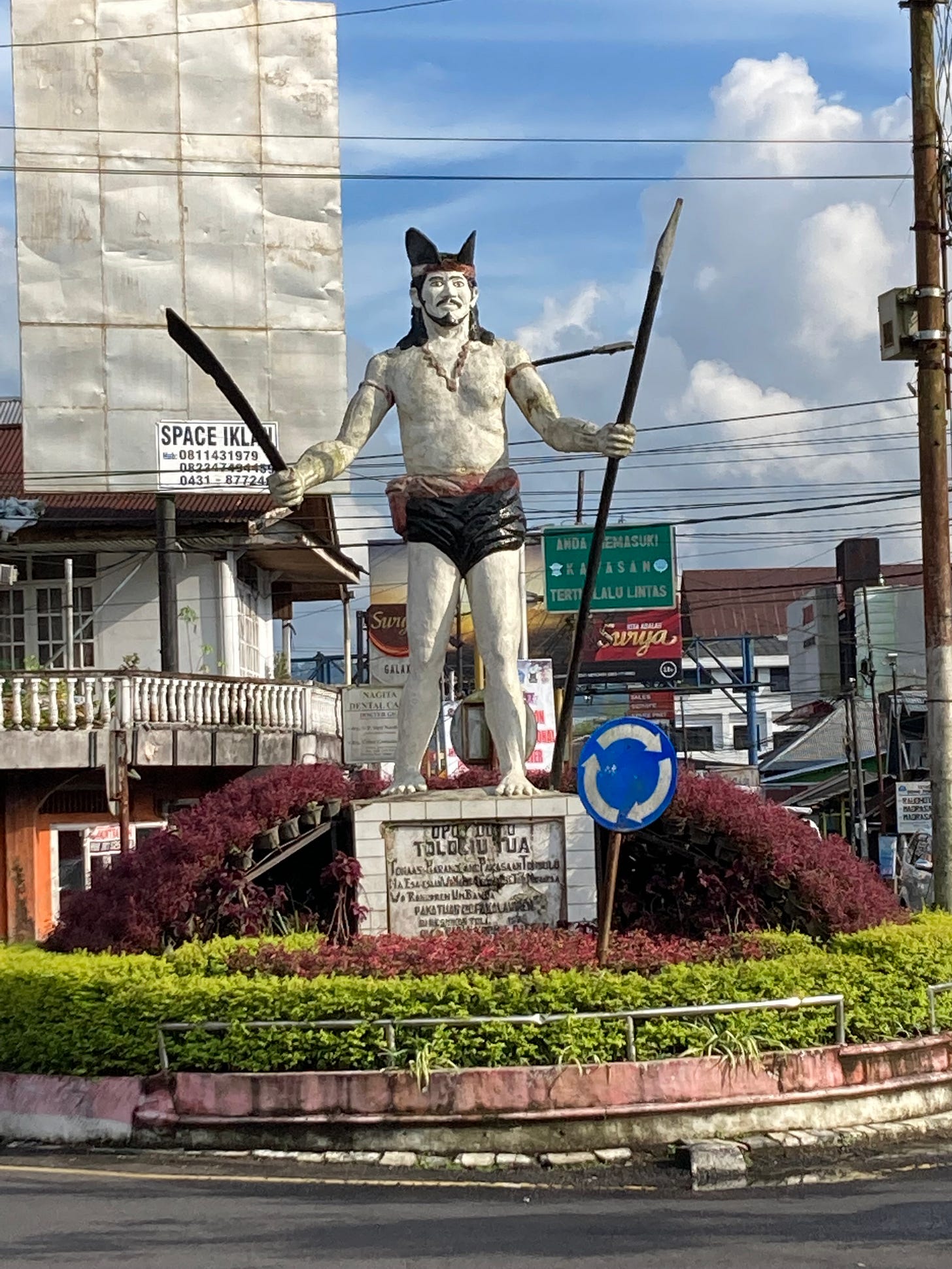
Tribal names like Tombulu give us a glimpse into the way the language works. The word Tou means ‘human being’- an ancient Austronesian word, variations of which occur from Taiwan to Tahiti and New Zealand. Wulu or bulu means ‘bamboo’, so Tombulu- Tou-mbulu - means ‘People of the Bamboo’. Tontenboan, ‘Tou-ntembo-an’ means approximately ‘people from the high place’, referring to the mountainous country west of Tomohon. Similar names occur throughout the region- Tondano (Tou ndano), a lakeside town which was the site of a 19th century rebellion against the colonial government, means, logically enough, ‘People of the Lake.’ A word like ‘wanua’ (meaning ‘village’ or ‘land’) takes affixes to change meaning and create new words- kawanua (local/native), mbanua (of the village), and so on.
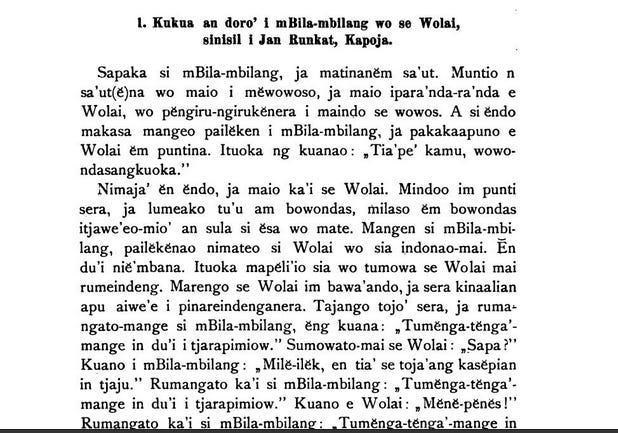
These people, who unlike Western Indonesia did not write prior to colonization, nevertheless had an extensive and sophisticated oral literature, some of which was written down by European linguists and missionaries in the late 19th century. As is typical for tribal Indonesia and the Western Pacific, myths and sagas are extremely local; heroic legends and even the creation of the world take place within the Minahasa Peninsula! The first man and woman were born on a particular mountain (or in one version, hatched from a coconut on the beach), and met near a particular boulder- Watu Pinawetengan, a real place still visited and considered sacred by some people today. Here, as elsewhere in the world before the Great Forgetfulness of modernity, every hill and stream was part of a story.
Today, the Minahasa languages are rarely used by anyone younger than 50, except in a few old church hymns, or as surnames- given names are all Western. Official statistics say that there are around 100,000 speakers of Tontemboan, the most widespread of the group, but I would put the number of really fluent speakers at considerably less. Several of the smaller languages are nearly extinct. Despite the well-meaning efforts of anthropologists and local historians, there is little general interest among locals in keeping them alive- the traditional lifeways with which the languages are inextricably bound are fading fast.
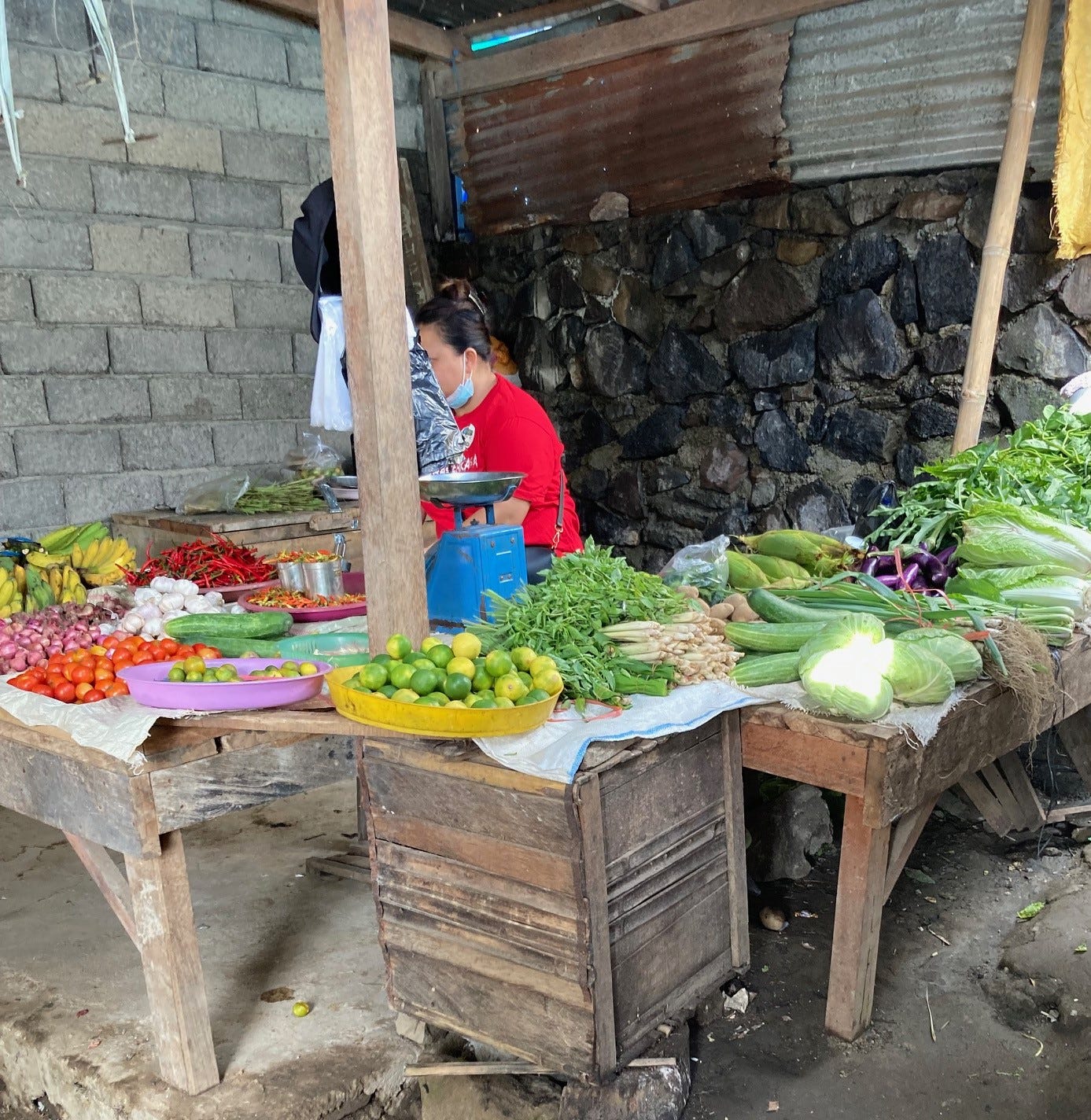
People are poor here, and ancestral languages and customs today have diminishing value for most, in an age when survival comes not from knowing the name of every edible plant in the jungle, but from getting the right college degree for a respectable career. You can’t really blame them- it has been a long time since traditional farming or fishing provided enough income to support a family, which in Indonesia often includes three generations plus assorted cousins and aunts!
Most young people would rather learn English or Chinese, competing languages of commerce and development- a desire with which China and the West are all too happy to comply. The same story could be told across Indonesia, from Sumatra to Papua, and in many other parts of the world. In a few generations there will inevitably be renewed interest among young intellectuals (as, for example, in the case of Gaelic in Ireland and Scotland), who will produce many PhD theses about ‘indigenous linguistics’, but by then it will be too late. As with animals, languages die out when they can’t adapt to new circumstances, a tragedy for which there is probably no remedy.
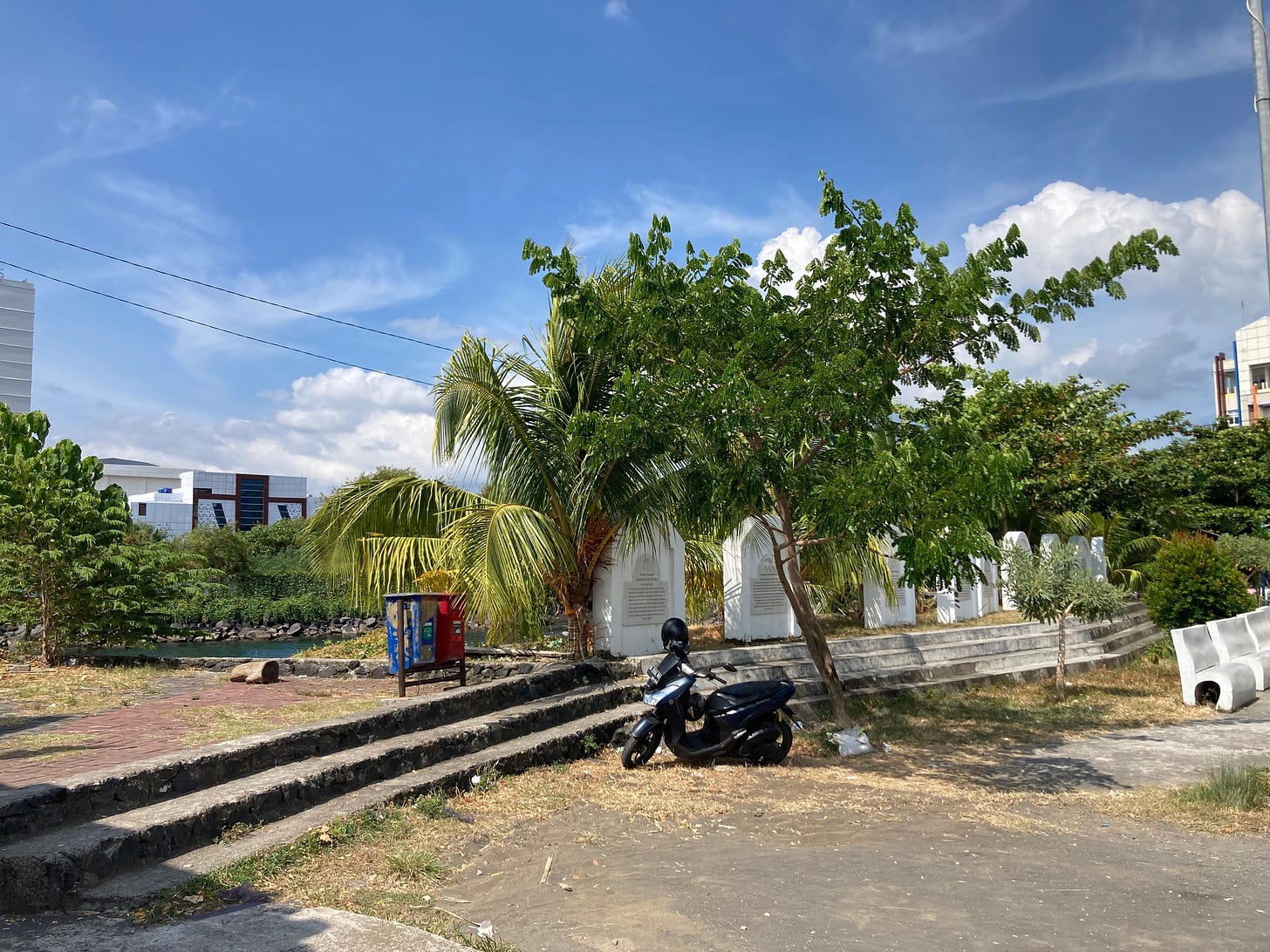
I exit the little blue bus as it jolts to a stop on the outskirts of Tomohon. The old men continue on, into the hills, among which they lived and under which they will one day sleep. When they go, the language will go with them, perhaps lingering for a few decades in little hamlets tucked away in the mountains; its passing will bring forever to a close a chapter in the long history of mankind. Yet the rolling hills remain..




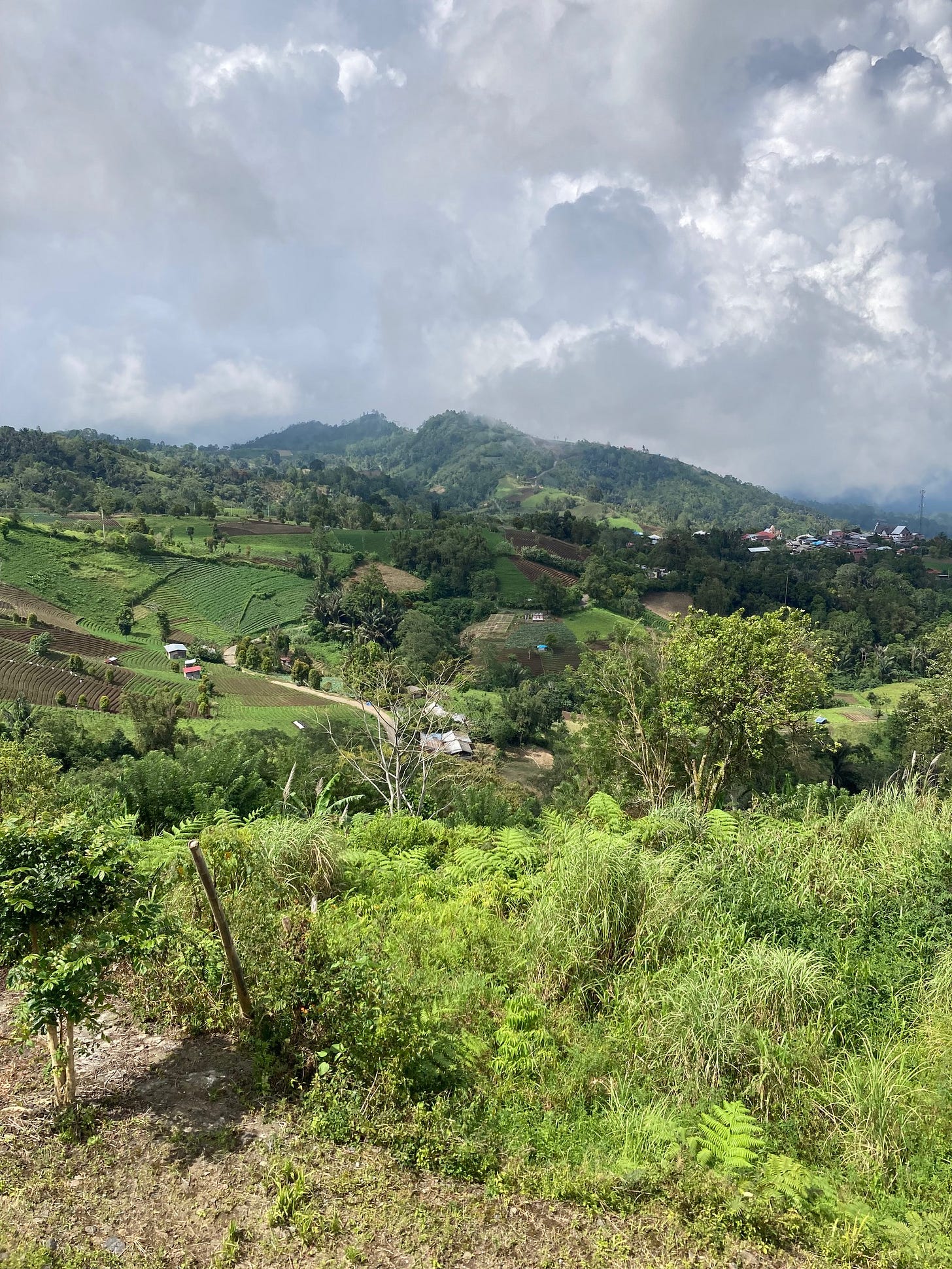
I love the beautiful descriptions of Indonesia, and the writers' comments on the changes occurring there. I can no longer travel to such distant places but I feel that I can get a feeling for that beautiful and interesting country by the poetic descriptions of the author. Thank you so much.
Beautifully written and fascinating in content! I loved the video. The speaker and language seemed so peaceful, as was the work done by the "artist". A pace of life which is by western standards, slow, but is deliberate, and has purpose and meaning.